Related Research Articles
Gun laws and policies, collectively referred to as firearms regulation or gun control, regulate the manufacture, sale, transfer, possession, modification, and use of small arms by civilians. Laws of some countries may afford civilians a right to keep and bear arms, and have more liberal gun laws than neighboring jurisdictions. Countries that regulate access to firearms will typically restrict access to certain categories of firearms and then restrict the categories of persons who may be granted a license for access to such firearms. There may be separate licenses for hunting, sport shooting, self-defense, collecting, and concealed carry, with different sets of requirements, permissions, and responsibilities.

In firearm designs, the term single-shot refers to guns that can hold only a single round of ammunition inside and thus must be reloaded manually after every shot. Compared to multi-shot repeating firearms ("repeaters"), single-shot designs have no moving parts other than the trigger, hammer/firing pin or frizzen, and therefore do not need a sizable receiver behind the barrel to accommodate a moving action, making them far less complex and more robust than revolvers or magazine/belt-fed firearms, but also with much slower rates of fire.

The M1 carbine is a lightweight semi-automatic carbine that was issued in the U.S. military during World War II, the Korean War and the Vietnam War. The M1 carbine was produced in several variants and was widely used by paramilitary and police forces around the world after World War II.

The Colt Single Action Army is a single-action revolver handgun. It was designed for the U.S. government service revolver trials of 1872 by Colt's Patent Firearms Manufacturing Company and was adopted as the standard-issued pistol of the U.S. Army from 1873 until 1892.

The .45 ACP, also known as .45 Auto, .45 Automatic, or 11.43×23mm is a rimless straight-walled handgun cartridge designed by John Moses Browning in 1904, for use in his prototype Colt semi-automatic pistol. After successful military trials, it was adopted as the standard chambering for Colt's M1911 pistol. The round was developed due to a lack of stopping power experienced in the Moro Rebellion in places like Sulu. The issued ammunition, .38 Long Colt, had proved inadequate, motivating the search for a better cartridge. This experience and the Thompson–LaGarde Tests of 1904 led the Army and the Cavalry to decide that a minimum of .45 caliber was required in a new handgun cartridge.
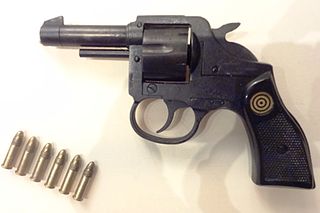
Saturday night special is a colloquial term in the United States and Canada for inexpensive, compact, small-caliber handguns made of poor quality metal. Sometimes known as junk guns, some states define these guns by means of composition or material strength. In the late 19th century and early 20th century, they were commonly referred to as suicide specials.

The .45 Colt (11.43×33mmR), is a rimmed, straight-walled, handgun cartridge dating to 1872. It was originally a black-powder revolver round developed for the Colt Single Action Army revolver. This cartridge was adopted by the U.S. Army in 1873 and served as an official US military handgun cartridge for 14 years, before being replaced by the .38 Long Colt in 1892.

Armscor Global Defense, Inc. is a firearms manufacturing company based in the Philippines. It is known for its inexpensive 1911-pattern pistols, revolvers, shotguns, sporting rifles, firearms parts and ammunition. Armscor, whose manufacturing facility is located in Marikina, produces about 200,000 firearms and some 420 million rounds of ammunition a year, where 80 percent of this is exported and sold to over 60 countries. The company was known as the Arms Corporation of the Philippines (Armscor) until 2017.

The Barrett M82 is a recoil-operated, semi-automatic anti-materiel rifle developed by the American company Barrett Firearms Manufacturing.
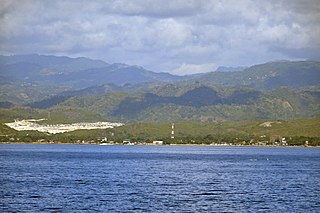
Compostela, officially the Municipality of Compostela, is a 3rd class municipality in the province of Cebu, Philippines. According to the 2020 census, it has a population of 55,874 people.

Danao, officially the City of Danao, is a 3rd class component city in the province of Cebu, Philippines. According to the 2020 census, it has a population of 156,321 people.

The M1917 Enfield, the "American Enfield", formally named "United States Rifle, cal .30, Model of 1917" is an American modification and production of the .303-inch Pattern 1914 Enfield (P14) rifle, which was developed and manufactured during the period 1917–1918. Numerically, it was the main rifle used by the American Expeditionary Forces in Europe during World War I. The Danish Sirius Dog Sled Patrol on Greenland still use the M1917, which performs reliably in Arctic conditions, as their service weapon.
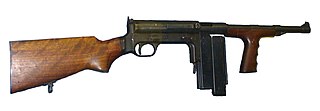
The United Defense M42, sometimes known as the Marlin for the company that did the actual manufacturing, was an American submachine gun used during World War II. It was produced from 1942 to 1943 by United Defense Supply Corp. for possible issue as a replacement for the Thompson submachine gun and was used by agents of the Office of Strategic Services (OSS). However, its usage was limited, and the Thompson continued to see service until the end of the war, alongside the M3 submachine gun, which was designed around the same time as the M42.
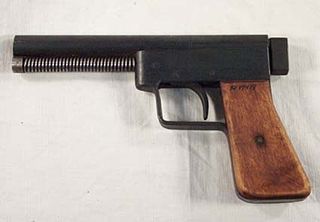
Improvised firearms are firearms manufactured other than by a firearms manufacturer or a gunsmith, and are typically constructed by adapting existing materials to the purpose. They range in quality from crude weapons that are as much a danger to the user as the target to high-quality arms produced by cottage industries using salvaged and repurposed materials.

Colon Street is a historical street in Cebu City. Located in the city's downtown, Colon Street is often referred to as the oldest and the shortest national road in the Philippines. It is named after Cristóbal Colón. Built in 1565, the street traces its origins to Miguel Lopez de Legazpi, the Spanish conquistador who arrived in the Philippines to establish a colony in the 16th century, and eventually developed the street under his leadership.
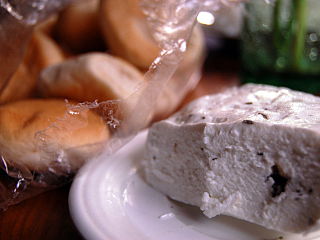
Kesong puti is a Filipino soft, unaged, white cheese made from unskimmed carabao milk and salt curdled with vinegar, citrus juices, or sometimes rennet. It can also be made with goat or cow milk. It has a mild salty and tart flavor. When an acidifying agent is used, it resembles queso blanco or paneer. When rennet is used, it resembles buffalo mozzarella. Moisture content can also vary, ranging from almost gelatinous to pressed and firm. It can be eaten as is, paired with bread, or used in various dishes in Filipino cuisine. It is usually sold wrapped in banana leaves.
Cimarron Firearms is an American firearms importer that has been in operation since 1984. The company's field of specialty is reproduction firearms from the American Civil War to the end of the Old West period. Founded by Mike Harvey in Houston, Texas, the company is now based in Fredericksburg, Texas.
Hilario "Dodong" Abellana y Hermosa was Filipino Visayan lawyer, politician and legislator from Cebu, Philippines. He was the municipal president of Cebu (1922–1931), a member of the House of Representatives (1934–1935), a two-term member of the National Assembly (1935–1941), and provincial governor of Cebu during World War II (1941–1943). After his escape and eventual captivity, he was executed by the Japanese Imperial Army and the resting place of his remains is still unknown.
Jose Delgado was a lawyer and politician from Cebu, Philippines who became mayor of Cebu City (1940–1942) and the governor of the province of Cebu (1943–1944), becoming the first person to have held both offices.
The creation, selling, and smuggling of illegal firearms is one of the most common criminal activities in the Philippines. Filipino-made local guns, built in secret factories, are sold and circulated not just in the country but also abroad.
References
- ↑ Barreveld, Dirk Jan (2015). Cushing's Coup: The True Story of How Lt. Col. James Cushing and His Filipino Guerrillas Captured Japan's Plan Z. Casemate. p. 261. ISBN 9781612003085 . Retrieved November 6, 2017.
- ↑ III, Lynn T. White (2014). Philippine Politics: Possibilities and Problems in a Localist Democracy. Routledge. p. 41. ISBN 9781317574224 . Retrieved November 6, 2017.
- ↑ Resource Material Series. UNAFEI. March 1997. Retrieved November 6, 2017.
- ↑ Jones, Doctor Adam (2008). Men of the Global South: A Reader. Zed Books Ltd. p. 268. ISBN 9781848131774 . Retrieved November 6, 2017.
- ↑ Barreveld, Dirk (2014). CEBU - A Tropical Paradise in the Pacific. Lulu Press, Inc. ISBN 9781312577190 . Retrieved November 6, 2017.[ permanent dead link ]
- ↑ Geneva, Small Arms Survey (2013). Small Arms Survey 2013: Everyday Dangers. Cambridge University Press. p. 311. ISBN 9781107435735 . Retrieved November 6, 2017.
- ↑ McCoy, Alfred W. (2009). An Anarchy of Families: State and Family in the Philippines. Univ of Wisconsin Press. p. 540. ISBN 9780299229849 . Retrieved November 6, 2017.
- ↑ Miani, Lino (2011). The Sulu Arms Market: National Responses to a Regional Problem. Institute of Southeast Asian. p. 111. ISBN 9789814311113 . Retrieved November 6, 2017.
- ↑ Philippine Law Dictionary. Rex Bookstore, Inc. p. 704. ISBN 9789712349119 . Retrieved November 6, 2017.
- ↑ Geneva, Small Arms Survey (2013). Small Arms Survey 2013: Everyday Dangers. Cambridge University Press. p. 314. ISBN 9781107435735 . Retrieved November 6, 2017.
- ↑ "Executive Order No. 171, s. 2003 | GOVPH". Official Gazette of the Republic of the Philippines. Government of the Philippines . Retrieved November 6, 2017.
- ↑ "GHOST GUNS". National Geographic. Archived from the original on October 20, 2016.